For many home sewers, the name Singer is synonymous with sewing machines. You may remember your mom or grandma using an old Singer machine while you were young, or you might own a modern Singer model yourself today! If you want to find out more about this familiar brand, there is a lot to learn about Singer sewing machine models, history, and value!
Founded in 1851, Singer pioneered many innovative sewing machine designs through the early 20th century, including the vibrating shuttle and the first electric-powered machine. For more than a century, Singer remained one of the largest retailers of sewing machines in the world. The Singer Company continues to sell popular machines today.
In this article, you’ll learn how this famous brand got its start. You’ll also find out which models remain the most popular today and how much it costs to buy an old Singer model.
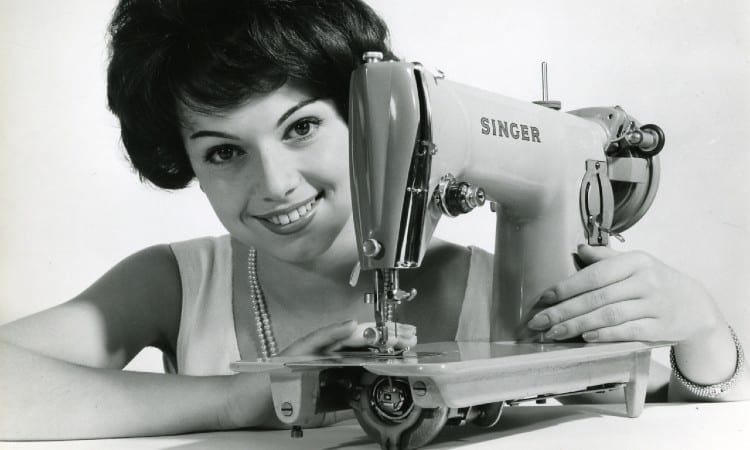
By Paolo Monti CC BY-SA 4.0
History of Singer Sewing Machines
First sold in 1850 and still popular today, Singer sewing machines have a long and quite lively history. Isaac Merritt Singer founded I.M. Singer and Co. in 1850. Contrary to popular thought, he did not invent the first domestic sewing machine.
Instead, he made modifications to a patented design invented by a man named Elias Howe. Singer did design and patent excellent modifications to the accepted design. But it was his business model that made the company a success.
What did he do that was so different? He launched the first popular installment payment plan for his machines. This made sewing machines affordable to the average person. Before this, only factories and companies owned sewing machines.
Singer also marketed the need for a sewing machine in every home. The company continued to develop accessible and more portable models over the years. The company also used a hefty door-to-door sales campaign and frequent model updates to keep customers buying new models.
Singer seized upon a radical business model at the perfect time. Sewing machine innovation and the industrial revolution hit their peak in the mid 19th century. You may also find it interesting that Isaac Merritt Singer’s personal life was as flamboyant as his business ideas!
The son of an immigrant, Isaac began his career as a Shakespearean actor. His extravagant personality did not fade away when he achieved success as a businessman later in life. He designed and drove around in a bright yellow carriage that could seat more than thirty people to show off his wealth later in his life!
During his itinerant life as an actor, he embroiled himself in relationships with multiple women at the same time. He continued this habit even more ostentatiously after he gained fame and wealth as a businessman.
In the 1860s, he had to step down from the leadership of his own company because of the scandal brewing over his affairs. By the end of his life, he had fathered 22 children with five different women. Who knew the world of sewing machines was so scandalous?
Though Singer died in 1875, the company he founded continued to thrive. Over the years, I.M. Singer and Co became the Singer Manufacturing Company and then the Singer Company. The company dominated the global sewing market for a century, from its inception in 1851 up until the 1950s.
Leading up to WWI, the company outsold the combined sales of all the other sewing machine companies worldwide!
It’s fascinating to note that the Singer Company was so huge and so powerful that it even had an impact on three major wars. The company supported the Union Army during the Civil War and provided machines to sew the army uniforms.
During both world wars, the company ceased sewing machine production for a time. Instead, they manufactured items under government contracts. These products included bombs and munitions!
Despite the war efforts, the early 20th century also saw a surge in innovative sewing machine designs. These innovations include the invention of the first electric-powered domestic machine.
Famously sold at the Chicago World Fair in 1934, the Featherweight 221 featured aluminum parts. This model exemplified the innovation of Singer sewing machines during this era.
After WWII, overseas competition for sewing machine manufacturing ratcheted up intensely. Both European and Japanese manufacturers flooded the market with new machines. This unprecedented level of competition pushed Singer out of its top seat in the market.
That said, Singer remains an extremely popular sewing machine manufacturing company today.
Singer Sewing Machine Models
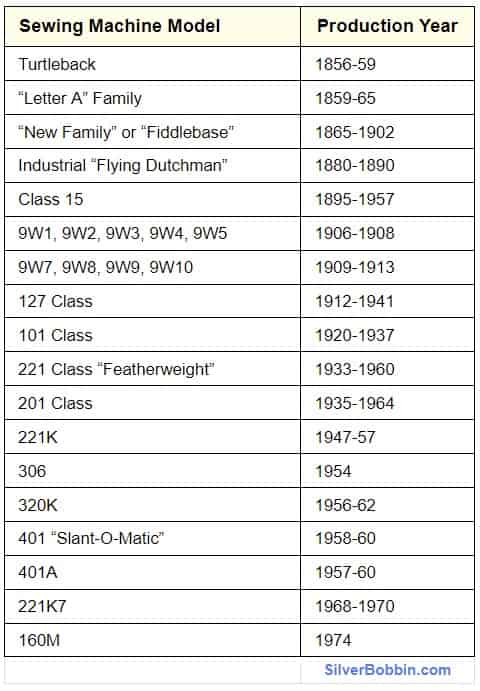
Since Isaac Singer sold his first machine in 1850, the company has patented and sold thousands of models. Some antique models remain popular for their rarity and collectibility. On the other hand, many vintage models remain popular for actual sewing today because of their high quality.
So, let’s get down to the nitty-gritty and look at a few of Singer’s most popular models over the years!
Popular Antique Models
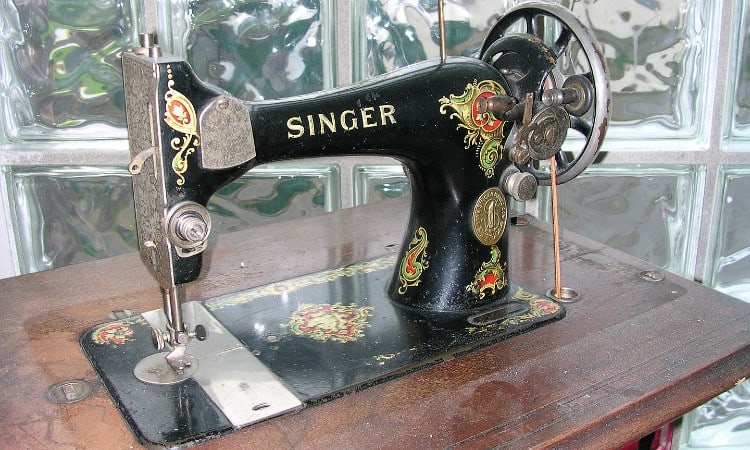
By Norbert Schnitzler CC BY-SA 3.0
Any sewing machine made before 1900 is considered an antique. This covers a wide timespan and hundreds of different Singer models. The company consistently delivered machines featuring new and improved designs during this era.
For example, in 1885 Singer sold the first machine with a vibrating shuttle. In 1889 they produced the first workable electric sewing machine.
It’s surprisingly difficult to track down a full Singer sewing machine model list. But out of all the many models sold during this timeframe, the Turtleback and the Fiddlebase stand out from the crowd.
Why do Singer machines have such cute nicknames? The names seem to have developed organically over time. They often stem from the appearance of the machine. For example, the “Fiddlebase” stars a beautiful violin-shaped metal plate that holds it to its wooden cabinet.
The Turtleback
Sold in 1856, the Turtleback served as Singer’s first machine designed specifically for domestic use. It also featured an iron treadle for the first time. While the Turtleback had some flaws, it remains a sought-after antique today because of its rarity.
The Fiddlebase
The Singer 12, also called the Fiddlebase, had more long-lasting success and lives on as a valued antique! It was the first reliable lockstitch machine on the market and could sew through multiple layers of fabric.
At the time, these innovations stunned the world. This model sold from around the end of the Civil War through the beginning of the 19th century.
Like the Turtleback model, the Fiddlebase remains extremely sought-after in the antique community. It’s easier to find these days, though, as thousands of models sold over the years!
Despite its age, you may find Fiddlebase models still in working condition today. They have durable metal construction and excellent design.
Popular Vintage Models
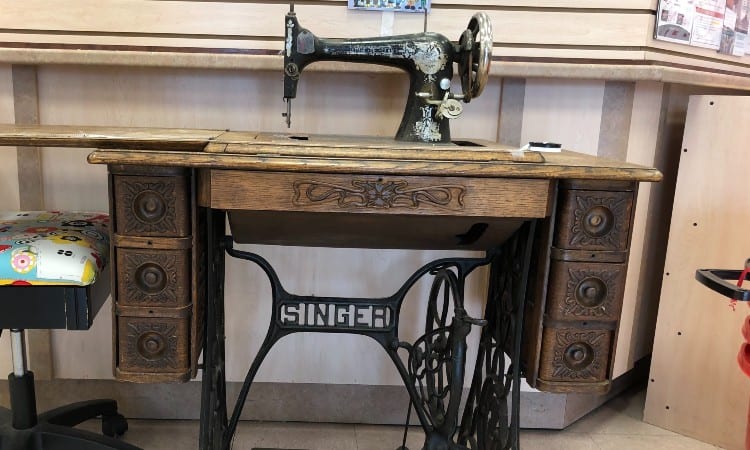
From 1900 through 1960, the Singer company manufactured hundreds of sewing machine models. Today, we consider these models vintage.
Vintage Singer models almost always feature solid metal interiors, heavy-duty construction, and reliability. If you have owned a vintage model, you can probably verify that they run forever!
While many vintage Singer sewing machines remain well-loved today, the Singer 221, 401a, and 66 models stand out as perhaps the best known of the vintage models.
The Featherweight
The Singer Company’s greatest success in the early 20th century was the Featherweight. More technically named Model 221, the Featherweight once again awed the world with its innovation. This model was made out of cast aluminum instead of the heavy cast steel previously used and weighed only eleven pounds!
The Featherweight also features several other unique qualities. It has a bed extension that hinges and flips up, allowing easy access to the bobbin case. It also has a distinct light placement that helps it stand out from the later models like the Singer 66.
The company launched the Featherweight model in 1933, between the world wars. It quickly followed this success with the 222K–the same model made and marketed out of Singer’s factory in Scotland. The 222K remains so beloved today that it earned the additional nickname of “Queen of the Singers!”
If you’re lucky enough to track down a Featherweight, hang onto it! These beauties might be old, but they often run like a charm. Quilters love these models because they sew easily through thick fabric that modern machines can’t stitch through. Plus, Featherweights usually cost a fair bit today because of their collectibility.
The Slant-O-Matic
Let’s jump ahead a bit to look at 1950s models. The models 401a and 403a remain popular today because of their solid steel components and their ability to zigzag stitch.
Called the Slant-O-Matic, the 401a is famous for its angled needle, allowing easier access to the needle plate and presser foot. This machine also features internal discs called cams. The cams redirected the needle and presser foot to enable different stitch patterns.
Today you will probably value the 401a and 403a mostly because they are as solid as a rock and will run forever. If you enjoy vintage sewing machines, you would be hard-pressed to find a better model than the 403a. It remains popular both for actual use and for its collectibility today.
1960-1980 Models
Models from the 1960s generally draw less attention from sewers and collectors. Partly this is because Singer faced stiff competition from overseas manufacturers at the time and responded by remaking several old favorites.
For example, you can find streamlined, space-age-looking Slant-O-Matic 500 models made in the 1960s. These pre-computer machines usually feature various stitching patterns and generally still have mostly metal cams and gears inside.
Models from the 1970s may disappoint you. Like most sewing machine manufacturers, the Singer Company began to transition from all-metal construction of cams and gears to mostly nylon and plastic parts during this decade. That said, it’s possible to find all-metal models made in the 70s, and these machines often run great fifty years later!
Singer models made in the 1980s through the present day usually have plastic components that degrade and stop working after five to ten years (though some may last as little as three years, depending on how heavily they are used). Modern sewing machines just aren’t made to last forever.
That said, new Singer models still have a lot to offer!
Modern Models
The Singer Company sold its first computerized sewing machine, the Quantum XL1000, in 1994. Today, almost every sewing machine for sale is computerized! Present-day Singer machines are usually viewed as mid-line quality, perfect for the home sewer but perhaps not on the same level as a Janome or Bernina machine for the professional seamstress.
If you sew a few hours a week, mostly just for fun, Singer models will offer you the quality and affordability you need! On the other hand, if you run an Etsy business and sew all day long, you may need a machine that can hold up to that amount of sewing.
Singer offers several models perfect for the beginning sewer especially. These include the 7363 Confidence Machine, the Start 1304 machine, and the M1500. These modern models provide a simple, easy-to-use design, a wide range of abilities, and affordable pricing.
How Old Is My Sewing Machine?
The easiest way to find out what year your machine was made is to find the model number on your machine. You can find this number inscribed on the machine in several places. Also, Singer has a great website with tips to help you track down the model number if you need more help!
Depending on the year it was made, you can usually locate the model numbers in one of the following places on your machine:
- Below the handwheel
- On the front panel above the needle
- Below the stitch length controller
- On a small metal plate on the front of the machine
Once you find the model number, you can conveniently type it into the search bar on Singer’s website to find the sewing manual and lots of useful information. Alternatively, you could also Google the model number and learn what year that model was manufactured.
You can also use the serial number on your machine to find out when it was manufactured.
Singer Sewing Machine Serial Numbers
Every Singer sewing machine has a serial number as well as a model number. Sometimes you can find these numbers in the same place. For example, older machines usually have these numbers inscribed on a small metal plate on the front of the machine. Newer models often place the serial number near the on/off switch or underneath the machine.
You can use the serial number as an identifier to determine the model number, the year your machine was made, and even how much it is worth!
The International Sewing Machine Collectors Society provides a database of all Singer serial numbers. Find your number in this database and you will know how old your sewing machine is.
Singer Sewing Machine Value
Singer sewing machine models typically sell for $50-$500, depending on the model and its collectibility. That said, you can also find rare collectible models that sell for over $2,000! In general, antique and vintage sewing machine value depends on the year of production, the rarity of the machine, and its condition.
Some vintage models sell for as little as fifty dollars. Collectible machines like the Turtleback may occasionally sell for over $1,000, but usually even collectible antique sewing machines price between $500-$1,500.
The Featherweight, a sought-after model for both actual sewing and collecting, usually prices out around $400-$600 on eBay or at antique stores. That said, the 222K (the same model but manufactured in Scotland) can sell for as much as $2,000 because it is rarer today!
A model that had limited production often ends up a collector’s item because of its rarity. This is what makes the Turtleback so valuable today.
On the other hand, the condition of the machine matters a lot, too. Antique dealers have a rating system to assess the appearance and working order of sewing machines. A machine in like-new condition will cost more than a rusty clunker pulled out of someone’s garage.
Finally, it’s generally true that older items cost more. A machine made in 1851 is more valuable today than a machine made in 1980.
How Much Is My Machine Worth?
You can easily determine the average worth of your sewing machine by locating its model number and searching on eBay or Etsy to see what other sellers have priced the model at.
Pricing an Antique Sewing Machine Today
You can find pricing information for antique machines from online sellers, official appraisers, antique stores, and even from library books! The easiest way to get a fair idea of what buyers will pay is to search eBay or Amazon to see what the sewing machine model typically sells for. If you need an official price for insurance or other purposes, you will need to find an official appraiser to look at your machine.
You can also find books that include information about the historical prices of collectible items such as antique sewing machines. These will give you an idea of the long-term worth of your investment.
You might also want to stop in your local antique store and chat with the dealer. These experts might have the inside scoop on a particular Singer model.
Before you get too excited, most antique and vintage sewing machines sell for less than $200. So unless you have a Featherweight on your hands, it’s unlikely you will make a lot of money moving sewing machines.
Of course, the flip side of this is that you can buy quality, workable vintage machines without spending an arm and a leg!
Where to Buy an Antique or Vintage Singer
You can easily find a wide variety of antique and vintage Singer models for sale online, usually for affordable pricing. Singer manufactured hundreds of thousands of machines over the years. This means you can pretty much find a vintage Singer in every antique store you visit, too!
If you’re lucky, you might even find one at a yard sale, estate sale, auction, or in a nearby thrift store. The catch with spotting a low-priced sewing machine somewhere like a thrift store is that you won’t know what kind of condition it’s in. If you buy from a verified seller online or an antique store, you will have a better chance of buying a machine in good working order.
How do you know if the machine will run? Well, if you’re shopping in person, you can always plug it in and take it for a spin! Listen to the sound it makes to see if it gets loud or makes odd skipping noises.
If you’re shopping online or aren’t allowed to touch the machine, look for obvious issues like cracks or rust. If the antique machine is housed in a wooden cabinet, check to see if the wood looks smooth and cared-for. The condition of any decorative touches like painted flowers or gold leaf also impact the value of the machine.
Of course, if you want the machine for personal use, the decoration doesn’t matter as much as the operation of the machine.
Value of Old Singer Sewing Machine in Wood Cabinet
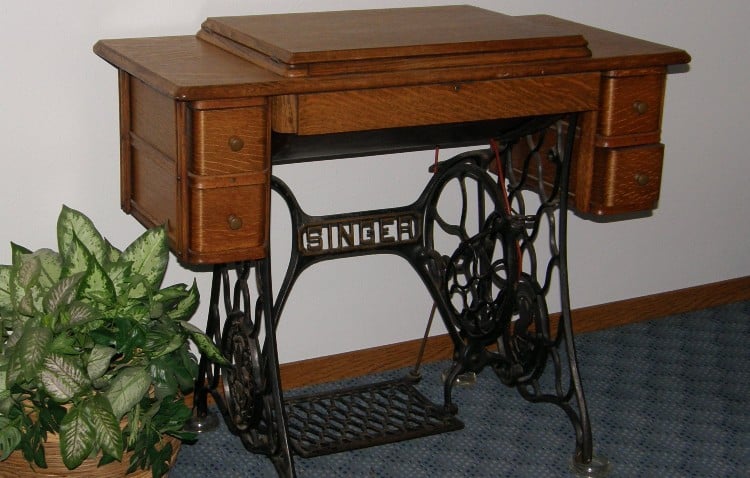
By Jim Hammer
The value of an old Singer sewing machine in a wood cabinet depends on its model number and condition, just like any other antique sewing machine. That said, machines in wooden cabinets tend to be older, which can give them more value.
The condition of the cabinet will also play a role in determining the value. Singer’s early treadle machines almost all came in wooden cabinets. This means that most antique and vintage models in wood cabinets were manufactured in the second half of the 19th century or in the early 20th century.
Ultimately, though, the collectibility of sewing machines usually depends on their rarity. Singer made so many machines that most of them don’t sell for much money.
If your machine runs smoothly and still sews, its value will increase no matter what model number it has! You can find vintage machines that run well with cabinets for sale at an average price of $200-$300 on eBay today.
Conclusion
The Singer Company dominated the sewing machine market for a full century, from 1850 to 1950. Collectible antique models from the company’s early years include the Turtleback and the Featherweight.
Vintage Singer machines remain popular today because of their durability. A couple of the most popular vintage machines for using today include the Singer 221 and the Singer 403a. Of course, many home sewers have their own beloved Singer model that they prefer!
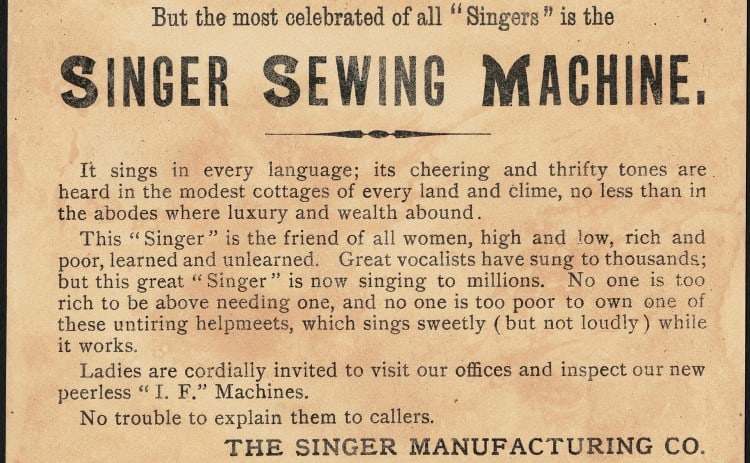

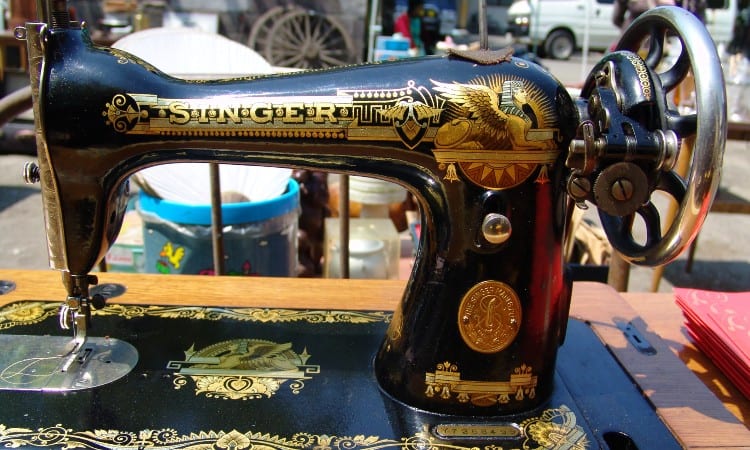
Darockchick
Tuesday 2nd of November 2021
The truth of the matter is a sewing machine like anything else is worth what someone is willing to give you for it. It's impossible to put a value on the antique and vintage machines. Less and less people are sewing and even less are collecting.
Kevin Colley
Monday 1st of November 2021
I have a old Singer Industrial Type I believe. These are the #'s I can find on it W924019, 112W140, P-1464. I tried looking up these numbers but nothing came up. It has a foot treadle and also a motor set up. Not sure if the motor was added in a later year. My dad had it stored away and I remember him using it before he passed in 2020.